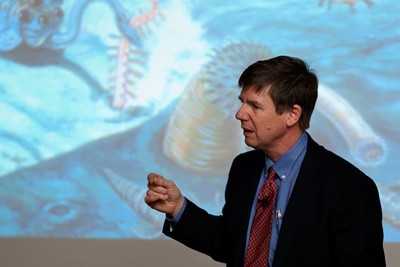Smithsonian scientist searches for roots of biodiversity on Darwin's birthday
By Joseph Mansky
In just 20 million years, animal life went from "microbial mats with things living on them" to "a food web ecosystem that, quantitatively, is no different in structure from modern food webs," said Doug Erwin, Smithsonian Institution curator of paleobiology at the National Museum of Natural History. His talk, "Constructing Biodiversity: From Darwin to the Cambrian Explosion," in Goldwin Smith Hall was the keynote address of Ithaca Darwin Days, Feb. 12, to celebrate Charles Darwin's 201st birthday.
Ithaca Darwin Days, sponsored by Cornell and the Paleontological Research Institution's Museum of the Earth, included panel discussions and lectures by Cornell and visiting scientists. The theme of this year's events was evolution and biodiversity, in line with the United Nations naming 2010 the International Year of Biodiversity.
The Cambrian explosion, which occurred about 530 million years ago, was a time when, according to Erwin, "fish, the first vertebrates, and all sorts of complex life" appeared over a geologically brief time period.
An ecosystem developed, Erwin said, from the explosion's "spillover effects." Animals, he said, modify their environments primarily through either niche construction or ecosystem engineering. In niche construction, organisms influence their environment in a way that helps their species to persist, like beavers building dams. In ecosystem engineering, organisms modify their environment but not necessarily for the benefit of the species, such as oysters filtering water. Both behaviors cause physical and chemical spillover effects that "are the clue to what happened in the Cambrian explosion," Erwin said.
"At the beginning of the Cambrian revolution, the oceans became oxygenated for the first time and the sediment became ventilated from burrowing," he said. Sponges probably played a large role in oxygenating the ocean, which allowed more complex life to evolve, and organisms' burrowing both aerated the sediments and changed their chemical composition. These changes had spillover effects "that affected the rest of the ecosystem and allowed for the growth of biodiversity."
Yet, he said, "we don't actually know how to build biodiversity." While the government focuses on the number of species, there are many other ways to count diversity and how it has changed over time, ranging from morphological and architectural to evolutionary approaches. The study of "different aspects of diversity … tells us something different about how you build these different kinds of diversity," Erwin said.
Joseph Mansky '12 is a writer intern for the Cornell Chronicle.
Media Contact
Get Cornell news delivered right to your inbox.
Subscribe